What is going on?
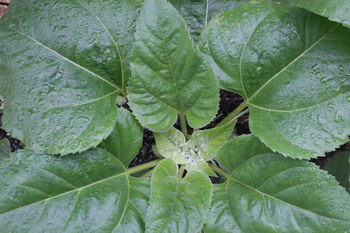
Rain? In June??????

What’s next? Unicorns? World Peace?
What is going on?

Rain? In June??????

What’s next? Unicorns? World Peace?
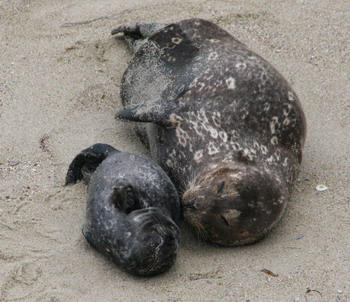
The story of the seals in the Cove at La Jolla and the dispute over whether or not they should be dispersed just took another turn:
At a cost of nearly $700,000 the city of San Diego wants to use a loudspeaker that emanates a barking dog sound from 6 A.M. till sunset and have police personnel on site to protect the person carrying/operating the device. If needed, even over the course of several years.
At nearly $700,000 per year (and rising, of course)?! Can one imagine a better use of taxes in times when we are told every day that we have to tighten our belts?
Angry Over Seals
Barking At Seals
Banished From Beach
More background information on all of this and the law suit running now since over 10 years can be read here:
I just can imagine how pleased those citizens of La Jolla living near the Cove will be to be woken up every morning at 6 o’clock sharp by the sound of barking dogs.
And the kids! They will love it! “Mommy, Daddy, can we go down to the beach where the dogs bark all day and the man runs around who carries the machine making the noise, while two policemen take care that everybody is safe during this event?”
Yes, that is what kids and neighbors and guests in the hotels lining the Cove love. Much more than seals. Because seals apparently are a nuisance.
And what about those who want to see marine mammals in the only seal rookery between San Francisco and Mexico? Why, they can go to SeaWorld and pay about $60.00 to stare at some seals in a tank.

Besides the Natural History Museum of Los Angeles County and the California African American Museum the park is home to the California Science Center, part of which is the Sketch Foundation Gallery – Air and Space Exhibits.
Just to make sure that nobody who wants to visit the gallery gets lost, they decorated the outside of the building (architect: Frank Gehry) with a jet fighter plane.

Another impressive outside exhibit is a Titanium A-12 Blackbird trainer, the one and only ever built.

It is easy to detect that this is a “trainer plane” – two cockpits! Just like driving school – two sets of instruments for managing the vehicle, only at a speed of Mach 2.0.
Also on display outside is a DC 8:

Although I am not quite sure whether this plane hasn’t been put up in conjunction with the Ornithological Society of Los Angeles – it is basically “Starling Central.” Yes, I kid you not, in every single opening of the hull starlings have built nests with loudly muttering offspring inside and parent birds frantically flying to and fro to feed the hungry brood. Here one can see the tail of a a starling slipping inside to tend to the kiddies:
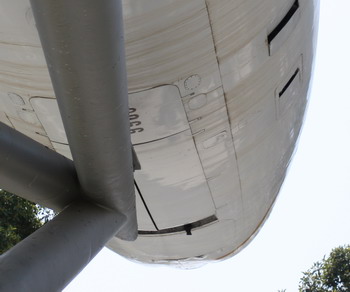
And it’s okay with me. Starling, A-12 or DC 8 – I love all things with wings.
A fun fact about the Los Angeles Memorial Coliseum: it is the only stadium worldwide which was used twice to host the Olympic Games – in 1932 and 1984. Hard to imagine in a city like Los Angeles where razing buildings seems to be a popular sport, but there you are. In this case they didn’t (and now they can’t because it has been declared a National Historic Landmark).
Of course the stadium was overhauled, renovated and spruced up for the 1984 games. Part of this process was the erection of the “Olympic Gateway”:

This statue with two nude torsos, cast after the bodies of a male and female athlete taking part in the 1984 games, is the work of the sculptor Robert Graham, who died last year. The sculpture might have led to a minor scandal before the games even started, because the Atlanta (Ga.) Committee for the Olympic Games requested from the officials of the Coliseum to cover up the figures; the reason given was that television viewers might catch a glimpse of the figures and find them indecent.
A tip of the hat to the Coliseum officials – they issued a firm refusal and that was that. No scandal and no “Wrappers for Art” either. To this day the statues are in place, uncovered and a splendid modern take on the Olympic games of old, where the Greek athletes competed in the nude.
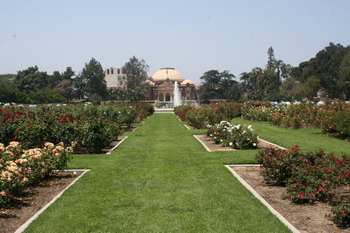
For lovers of roses the place to go is the Rose Garden at Exposition Park. Interestingly the roses (about 200 varieties and approx. 20.000 rosebushes) are presented like a collection, nicely divided into individual plots, like stamps in a collector’s album. The garden itself is on the smallish side with just 7 acres (28.000 qm), but it is so well laid out that it never appears cramped or overcrowded. With lovingly manicured lawns, a fountain and several buildings as backdrops it is also a popular venue for weddings and other festivities.
Of course this would not be Los Angeles if such a lovely piece of real estate had not been eyed for “better uses” in the past. In 1986 the garden was threatened to be dug up to make room for an underground parking garage. This plan led to loud protests. My favorite opinion comes from the Los Angeles Times of that year with this memorable editorial:
“There are times when the leaders of Los Angeles seem perversely intent on living up to the image that many outsiders have of them—insensitive and uncouth rabbits who would, say, dig up a garden to put in a parking lot.”
Whatever one might think about the Los Angels Times today, way back then they got it right and they certainly did not mince their words. This was not the only, but the last threat to the Rose Garden. In order to protect it, it was added to the National Register of Historic Places in 1991.
And now for some roses. Just imagine the scent hanging over the garden and enjoy.
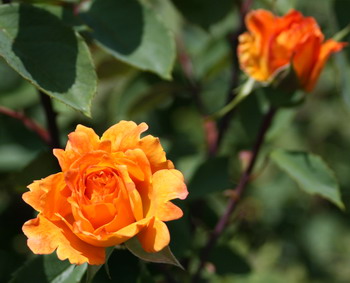

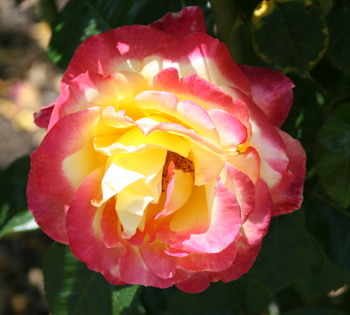
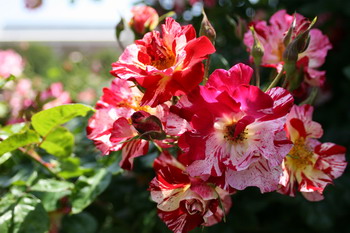
Two more examples of fabulous signs in prime Googie style.
Bob’s Big Boy in Burbank:
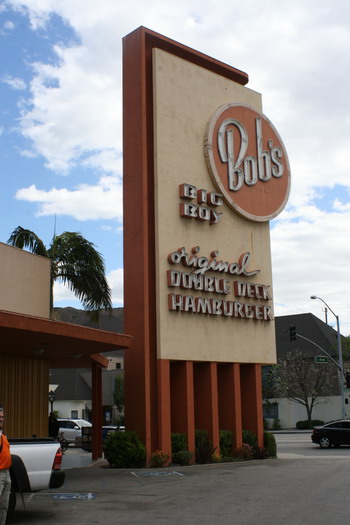
This is actually the very first building done for the chain by architect Wayne McAllister; it’s been sitting there in Burbank since 1949 and was declared a California Point of Historical Interest in 1993. Which is more than merited, because McAllister and his very distinct take on form, function, color and fun paved the way from Streamline Modern to Googie.

Bob’s Big Boy in Burbank was designed as a drive-in and the present owners revived the car-hop service (at least on weekends). They also restored the Big Boy’s sign to its full glory. Well done, I say.
Another chain of diners, very unique to SoCal, is Norms:

This sign is already a slightly later adaption of the original style, which can be seen here. But the basic strong language of form and color never changed, which is laudable. The first Norms was designed by the architectural firm of Armet & Davis, a company enormously influential in defining this very Californian style of the ’50s.
And yes, Norms never closes – since 1949.
So we finally made it to the Hoover Dam. We were prepared to be impressed. And we were, when we saw this:

This is the new Hoover Dam Bypass; work started in 2005, it is scheduled to be finished in 2010. Then one will travel 840 feet (256 m) above the Colorado River on a four lane highway.
Two more closeups:
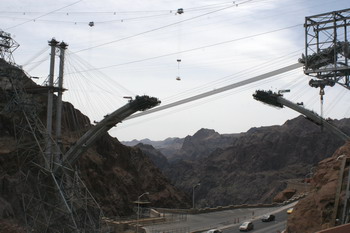

The Hoover Dam itself is a marvel of engineering, given the time it was built and the enormity of the task involved. But the new bypass is just overwhelming. Or WOW! With a well-deserved exclamation mark.

Plane landing at Las Vegas Airport
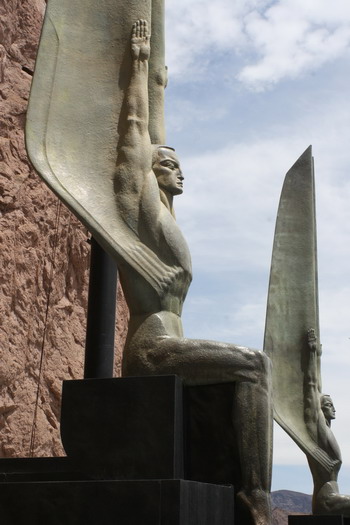
“Winged Figures of the Republic” by Oskar J.W. Hansen at Hoover Dam
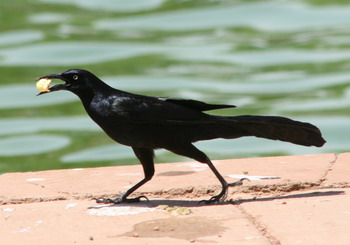
Greedy Grackle
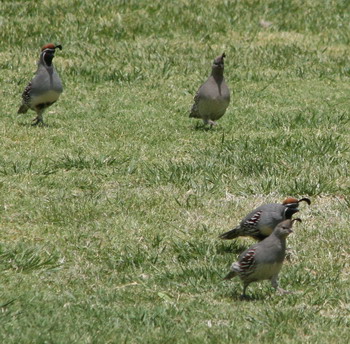
Flock of California Quail
Out of Art Deco, enthusiastically adopted in the US, grew a style unique to the United States – Streamline Moderne. It evolved in the ’30s and was both a modern continuation and a reaction to Art Deco, which surprisingly enough is not a contradiction, although at first it seems to be one.
Streamline Moderne reflected the more austere economic times of the ’30s. Some Art Deco elements were kept, but generally sharp angles and lines became more aerodynamically rounded, excessive ornaments gave way to clean surfaces and – very important – modern materials like cement and glass were used to replace exotic woods and stone.
In Los Angeles the Lydecker House is usually quoted as a prime example of a residential building in the Streamline Moderne style. But there are many, many private houses around showing the rounded lines, the curved windows, the portholes so typical of that style.

Even more houses show only some of the elements – just some curved lines, one or two porthole windows; that was enough at that time to deem the house “modern” and satisfy the buyer that he or she was totally “with it.”
And then one can find something like this:

Here the theme of the rounded lines and the portholes has been taken to a certain extreme, in keeping with the name “The Good Ship Grace.” This building was originally a radio station for Christian broadcasting. Then the radio station moved out to Riverside and the structure just sits there – empty and as an example of a very unique American style.
With the weather report forecasting high temperatures of up to 93°F, we started early on our hike in the Deukmejian Wilderness Park. This park is another one of those lovely areas which escaped the fate of being “developed” through the City of Glendale buying the land and turning it into a recreational area.
It took only a very short while to discover a patch of green, dotted with lovely yellow flowers.

It turned out that these pretty little things are Ice Plants (Carpobrotus edulis), quite aggressive invaders. Brought to California in the early 1900s as a stabilizer for soil along railroad tracks, Caltrans was one of the companies who planted thousands of acres of it all over Southern California. C. edulis, originally from Africa, took a good look around, decided that SoCal was just the place to be and started doing what C. edulis does best – it spread. And spread. And spread some more. Today the plant has become a serious ecological problem, posing a threat to the local flora and has to be fought.
The next pretty sight was the Californian State flower, the Golden Poppy (Eschscholzia californica).
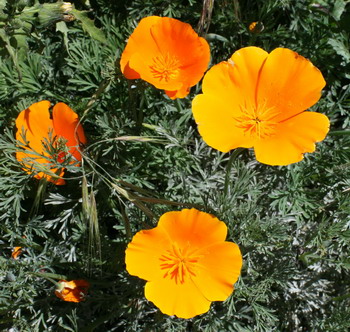
Now this truly is a native plant and always lovely to look at. Not that the Ice Plant isn’t lovely, but I found it quite interesting to see two plant species only about 20 paces apart from each other – one an intruder, one a native.